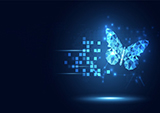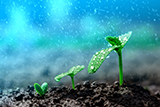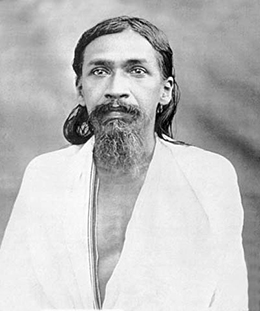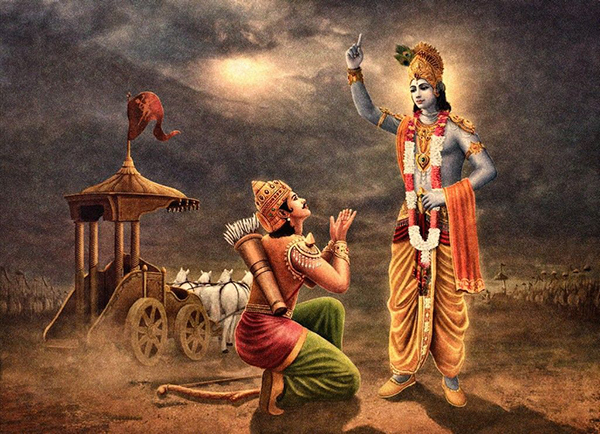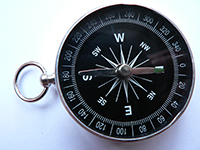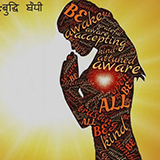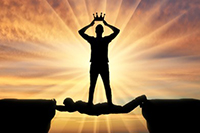Consciousness and health
Realms of the evolution of consciousness
Editor’s note:
The article is based on the author’s understanding of the dimensions and layers of consciousness as given by Sri Aurobindo. Its presentation is engagingly academic and hence carries its own importance. These are, however, not necessarily in the way Sri Aurobindo has revealed through his Works.
Abstract
Evolution is the journey of transformation. It deals with the concepts around change, development, growth, progress. Every object, context and being are in a constant state of change in the world, bound by time and space. This article attempts to describe evolution as it occurs in the world of matter and mind, the macro and the micro. The source of the framework used in this article has been adapted from Sri Aurobindo’s theory and philosophy on evolution. This story of evolution explains the three Realms of Inconscient Inactivity and Stillness, Conscient Activity and Movement and Super-Conscient Activity and Stillness. The three realms, while distinct, are also fluid and move back and forth. The framework describes the fields of operations, the transition dimensions, the movements and the realisation of potentialities through which all matter and beings operate and evolve. This article asserts that evolution is a conscious, continuous, inevitable process of transformation of the consciousness, moving from Inconscience to Conscience and to Super-Conscience. It also highlights the necessity for alignment in the physical, vital, mental and intellectual dimensions for experiencing oneness within and outside. This is what we mean by being in a state of whole, integral, complete fulfilment and well-being.
Introduction
Evolution is the journey of transition and transformation. It deals with concepts around change, development, growth, progress. Every object, context and being in the world is in a constant state of change bound by time and space.
At its core, evolution is a conscious, continuous, inevitable process of transformation of the consciousness, characterised by widening, heightening, deepening and finally, integration.
This article attempts to outline the evolution of the consciousness as it occurs in the world of matter, vital, mind and spirit. The source of the framework used in this article has been adapted from Sri Aurobindo’s theory and philosophy on evolution, the Mother’s writings and also derived from the Vedantic body of scriptures.
The following section explains the framework in detail, followed by the conclusions on the relevance and usefulness, both for individuals at a personal growth level and to get an understanding on the workings of objects and beings in the world.
Framework
Amongst all existing beings, humans are currently in the highest state of evolution. This is attributed to the presence of a rational intellect that can discriminate (Vivekabuddhi).This Viveka renders humans capable of persistent thought in their search for answers to the existential questions, ‘Who am I; why am I the way I am; why is the world the way it is ?’. It is also this intellect that allows humans to undertake this exploration into the evolution of consciousness.
Evolution deals with the unfolding of the consciousness, the underlying principle, the substratum, the cause and the effect of evolution. Consciousness is that energy within all objects and beings, the vitality behind the sense organs, the feeler potential in the mind, the light that illumines the intellect. Consciousness exists at all times, everywhere, in everything even when it may appear to be dormant, inert. For its awakening, it awaits for the right aspiration, preparation, readiness and nurturance to convert from inactive to active.
Sri Aurobindo explains evolution with another premise called involution which precedes evolution. This premise considers that it all began from nothingness, where there was no cosmos, matter, life, or spirit, only a consciousness. This consciousness had an aspiration, an urge to manifest and express the possibilities lying latent within.This urge then manifested as the cosmos and matter. Life emerged when the chemicals and gases in the cosmos rearranged themselves into life-supporting states (e.g. water). Progression took place from simple life forms to complex beings with mind, increasing perception and awareness of something larger than what is manifested.This consciousness then, which manifests, obviously must have been involved from the beginning in the whole of matter and in every knot, formation and particle of matter, life, mind and whatever is above mind.
Evolution and involution are processes reverse to each other. If evolution is considered to be a state of ascent, involution is one of descent. Evolution starts from nothingness to inconscient, to subconscient, to the formation of matter. Its goal is to reach the highest state of consciousness. Involution on the other hand is the unmanifested holding of all the inherent potentials and energy within.
A simple example of this is that the future tree is existent in the present seed. The process of the seed turning into a tree is evolution and the presence of the energy-force (consciousness) and the potentials within the seed to enable the transformation, is involution.
The nature of evolution is to transcend, co-holding multiplicity and simultaneity in its process. For the purpose of this article, we will focus the discussions along the realms of evolution, beginning at the stage of matter and its systematic progress thereafter. For a simpler understanding of this process, it is easier to conceive it as moving across three definitive stages of development and progress, referred to here as realms.
The three realms that capture the story of evolution are: The Realm of Inconscient Inactivity and Stillness; The Realm of Conscient Activity and Movement; and finally the Realm of Super-Conscient Activity and Stillness. These three Realms are where the world and all matter, objects and beings operate in.
The Realm of Conscient Activity and Movement lies in the middle. This is the field of activity, where action is inevitable. The human journey primarily takes place within this realm. This realm is the threshold for the growth of the consciousness. The Realm of Inconscient Inactivity and Stillness that occurs prior in forms of the nascent existence of the consciousness.
The Realm of Super-Conscient Activity and Stillness that occurs after, apprises of all the possibilities on alignment of the consciousness to the highest and operates from there. Evolution, moves from Inconscient Stillness and Inactivity to Conscient Activity and Movement to Super-Conscient Activity and Stillness. We can consider it as a movement from apparently inert matter towards life and rudimentary mind, as seen in the vegetable and animal kingdoms. This is followed by the evolution in human beings, who have a developed vital, mind and intellect.
And lastly, it is the movement towards a higher state of existence that transcends the limitations and boundaries of time and space.It is important to note that, while human beings are currently at the highest point in the cycle of evolution, they are not the end-point in evolution, “Man is a transitional being; he is not final; for in him and high beyond him ascend the radiant degrees which climb to a divine supermanhood (1).”
The dimensions and progression have been captured in the Table of page 21.We will now progress to the details across the fields of operations, the transition dimensions, the movements and the realisation of the potentialities through which all matter and beings operate and evolve.These realms are to be considered as distinct, but fluid with possibility of movement towards ascension and or descent, linear and or horizontal.
We will now systematically analyse each variable of study across the three realms.
1. Field
The field referred to here is the entire field of activity and all its constituents that operate within the field. In the Gītā (verses 13.4 -13.7), this is termed as the Kṣetra (2). It consists of the five great elements, individualised ego, intelligence, the unmanifested, the ten senses, the mind, the five sense objects, and the entire universe of feelings and emotions.
The field in the realm of the Inconscient Inactivity and Stillness constitutes the five great elements (Pañca Mahābhūtas) in their gross form with all the permutations and combinations within. The nature of the field is perceived to be inert, dormant and ignorant of the potentials lying within.
VARIABLE OF STUDY |
REALM OF INCONSCIENT INACTIVITY & STILLNESS |
REALM OF CONSCIENT ACTIVIT7Y & MOVEMENT |
REALM OF SUPER CONSCIENT ACTIVITY & STILLNESS |
FIELD |
Inaction |
Thought, Feeling, Action (TFA) |
Action in Actionlessness |
CONTROL COMPASS
| Fully driven by External |
Driven by External and Internal |
Fully Driven by Eternal |
MIND PLANE
| No Mind |
Mind & Intellect |
Higher Mind & above |
TRANSITION DIMENSION
| No perception or experience of Time, Space and Objects |
Experience of Time, Space & Objects |
Experience beyond Time, Space & Objects |
MOVEMENT OF THE CONSCIOUS PRINCIPLE
| Unconscious Incongruence |
Conscious Congruence |
Super - Conscious Congruence |
REALIZATION OF POTENTIALITIES
| Matter |
Life & Becoming |
Being |
In the realm of Conscient Activity and Movement, there is the full spectrum of the senses, mind, ego, intelligence, sense objects and the interplay of all the thought, feelings and action. This is the world of transactions (the samsara, the world). All the acts of doership, enjoyership, desires, attachments, and dualities existing here are that generated by the mind, strengthened by the mind and acted on by the mind. The individuation by the Mind and Ego (‘I’ness, ‘My’ness) occurs in this realm.
The Realm of Super-conscient Activity and Stillness is the field where effortless action flows, as if in a state of Actionlessness (3). Verse 4.18 mentions this as one who experiences‘action’ in ‘inaction’ and ‘inaction’ in ‘action’.There is no experience of doership, only of enjoyership. Sri Aurobindo mentions such a being as the Divine worker that, “...in the full flood of action the soul is free from its works, is not the doer, not bound by what is done, and he who lives in the freedom of the soul, not in the bondage of the modes of Nature, alone has release from works. This is what the Gita clearly means when it says that he who in action can see inaction and can see action still continuing in cessation from works, is the man of true reason and discernment among men. This saying hinges upon the Sankhya distinction between Purusha and Prakriti, between the free inactive soul, eternally calm, pure and unmoved in the midst of works, and ever active Nature operative as much in inertia and cessation as in the overt turmoil of her visible hurry of labour. This is the knowledge which the highest effort of the discriminating reason, the buddhi, gives to us, and therefore whoever possesses it is the truly rational and discerning man, sa buddhimān manuṣyeṣu, not the perplexed thinker who judges life and works by the external, uncertain and impermanent distinctions of the lower reason. Therefore the liberated man is not afraid of action, he is a large and universal doer of all works, kṛtsna-kṛt; not as others do them in subjection to Nature, but poised in the silent calm of the soul, tranquilly in Yoga with the Divine. The Divine is the lord of his works, he is only their channel through the instrumentality of his nature conscious of and subject to her Lord. By the flaming intensity and purity of this knowledge all his works are burned up as in a fire and his mind remains without any stain or disfiguring mark from them, calm, silent, unperturbed, white and clean and pure. To do all in this liberating knowledge, without the personal egoism of the doer, is the first sign of the divine worker (4).”
2. The control compass
The control compass specifies the governance; the where and how of the realm. The Realm of Inconscient Inactivity and Stillness is completely driven by the external, since here the consciousness appears to be inert and dormant. In effect it is the realm of being acted upon. For example, a stone appears inert and inconscient. It requires an external force or agency to change its shape or place. An example at the individual self level is when we are acting from a state of complete unawareness, having given our remote to someone outside who is expected to decide our actions and responses for us.
The Realm of Conscient Activity and Movement is dynamic and is driven both by the external and internal. There is choice, agency and effort available, which can be deployed for movement either towards inactivity, lower levels of awareness or towards Super-Conscient activity. The being has the choice to remain stationed in ignorance or move towards knowledge.
The Realm of Super-Conscient Activity and Stillness is fully driven by the internal compass connected with the Eternal. The being is fully aligned, established and anchored within and requires no external triggers or motivations.
3. Mind plane
The mind and vital, seat of all perceptions, thoughts, emotions and feelings, together direct all actions to respond to the stimuli from the external world. The mind and vital processes the stimulations received when objects come in contact with sense organs and provides a suitable response for the organs to act. The mind (manas) has the capacity of volition, perception, feeling, understanding, and deciding.
In the Realm of Inconscient Inactivity and Stillness, the mind is involved but not developed and evolved and therefore does not have the capacity to think or act.
In the Realm of Conscient Activity and Movement, the mind has different development states. For elementary beings (animal kingdom), the mind is not fully developed, nor capable of deep thinking. Here, the capacity of the mind is limited to receiving stimuli from the external mind, processing it as one of threat or safety and acting accordingly. The mind in lower beings operates mostly from a fright, flight or fight mode.The mind in human beings however is more developed and includes the vital. It helps the formation of individual identities and then goes further to establish relationship of the self with others.In the identification of the mind and vital with the body, the instrument is very strong, which in turn creates the differentiations of I-You, Mine-Others, etc. In order to make its importance and relevance felt, the mind controls and directs all action. This ego mind and vital thrive on the combination of fear, desire and attachment. These are the causes of pathos and sorrows that individuals experience in the world.
All these emotions are reasons for experiencing frozenness, indecision, ignorance, confusion and quite often leading towards wrong action choices.The instinct of self-preservation is a powerful and binding driver and a cause for the constant preoccupation for fulfilment of desires and gratification in humans. The mind and vital planes are the stage where the drama of the world of objects takes place, the play of cause and effect.
Humans are also armed with another capacity: the intellect (buddhi). This makes beings capable of recognising objects and concepts of the world, to compare, contrast, categorise, distinguish, visualise, create, imagine, discover and innovate. At an even higher level of the intellect, lies the ability to discriminate (vivekabuddhi), enquire into the existential relationships, to distinguish the difference between the Subject (the knower, experiencer) and Object (known, experience). This intelligence enables them to connect to the universal consciousness, the source of energy within and outside of them. However this experience and connectedness with the universal consciousenss is sporadic and not continuous. While this potential is innate and available to all, it is not tapped into equally by humans. This is because, it is largely dependant on the capacity and development of the consciousness in individuals.This realm is also strongly bound by nature (Prakṛti) and its three distinct qualities (guṇas): Purity and effortlessness in activity (sattva), Desire-charged activity (rajas), and Inactivity (tamas).
The combination of the three guṇas that can also be described as Knowledge and Light, Desire and Agitation, Ignorance and Inertia are prevalent in every individual in different proportions based on their inherent nature. All actions are performed in all cases depending on the qualities and tendencies of the nature (guṇas) of that individual (5). This is what brings out the uniqueness in each being by bringing out unique responses to any context. Extending this line of thought, the outcomes that follow are also unique and specific to individuals.
In the Realm of Super-Conscient Activity and Stillness, this intellect operates at an even purer, higher level and is likely to transcend from the ‘I’ness into the ‘One’ness. There is an awareness of the transient nature of the world of objects, its constantly changing nature. The being is in contact with the consciousness (Self) within and outside, identifying with ‘That’ which is unchanging, which truly exists, the true Self, the pure consciousness.Anchored beyond the individual self into a larger, and operating for the larger good. From ātma-kalyāṇa (wellness of individual self), it functions to the location of sarvakalyan (wellness of all). The mind therefore is deployed towards selfless service and oneness with no insistence on specific desirable outcomes for individual self.
4. Transition dimensions
The dimensions of Time, Space and Objects create a sense of finiteness, completeness and concreteness to the daily living processes. It helps to organise and maintain boundaries in the transactional world and creates differentiation and individualisation. Each object and being therefore can be defined independently as something physical, with specific shape, form and texture, nature and characteristics. The dimension of Time helps to bring the concept of dualities of creation-destruction and birth-death. Space helps to divide the physical (gross) into independent individualised objects.
In the Realm of Inconscient Inactivity and Stillness, there is no experience or perceptions of the dimensions of time, space and objects. The realm primarily provides the finiteness of the gross physical state of matter. An example could be a rock. It occupies space and it is an object having a distinct physical form and composition. Relatively speaking, matter appears to have no agency of its own, it cannot move or change its form unless assisted (acted upon).
Within the Realm of Conscient Activity and Movement, time, space and objects are all experienced. In this realm, change is continuously experienced. Time provides finiteness and definiteness to experiences. By dividing into past, present and future, time allows our mind to comprehend and experience the world and the objects, thoughts and feelings logically and sequentially as real and finite. This is also the realm of limitations and boundaries, compelling us to make choices of place and time, things and beings, happenings and circumstances, etc.
The concept of time creates existential fears. Being a scarce resource, it triggers feelings around hoarding, possessing and protecting. This in turn fuels desires, wants and attachments to objects and beings, spurring a vicious chain of operating from scarcity and limitations, overlooking abundance and generosity. The manifest and tangible experienced through perceptions, feelings and emotions take precedence and appear as the only reality.
Now, within the Realm of Super-Conscient Activity and Stillness, there is an expansion and transcendence of the consciousness beyond the dimensions of time, space and objects. The being is completely, wholly, integrally and fully living in the ‘eternal now’, in common parlance called ‘here and now’, when the mind usually ceases its acts of division and rests.
Therefore the being can experience infiniteness, changelessness, multiplicity, simultaneity, limitlessness and eternity. The existential concerns and fears around death cease since there is a getting in touch with the same infiniteness within the self and within others. The limitations of form and shape are realised and experienced in a continuum, where there is change in the material, physical, mind and vital but the consciousness is changeless, eternal, timeless, and imperishable. This is the dimension of experiencing the unmanifest. The unmanifest is not available through any one of the instruments of cognition, feeling or understanding. It is the higher consciousness which is the vitality behind the sense organs (mere eyes do not see unless the self is in there to see), the feeler-potential in the mind and the very light that illumines the intellect. “That which is hearing of our hearing, mind of our mind, speech of our speech, that too is life of our life-breath and sight of our sight. The wise are released beyond and they pass from this world and become immortal (6).”
5. Movement of the conscience principle
The process of evolution occurs both at the micro individual self level and at the macro level as a transition and transformation of consciousness. The degree and level of evolution of the conscious principle determines the realm from which the matter or living being is operating. So far, we have discovered matter as only the substance-form of force, and the material force as only the energy-form of Mind. It is actually the consciousness operating within a particular realm that determines the level of congruence and integration that the particular being or object experiences.
In the Realm of Inconscient Inactivity and Stillness, there is an experience of unconscious congruence. The field appears to be inert, not yet mentalised. The objects in this realm are complete in themselves, without awareness. They are governed completely by the external force of nature (Prakṛti). The kindling of aspiration from within for any progress is absent.
In the Realm of Conscient Activity and Movement the conscious principle is conscious and can experience congruence but only with self-effort. The congruence and integration is sporadic and unstable. The option available for beings in this realm is to progress and transcend to the next realm or go back in awareness, letting the aspiration die out. There is a back and forth in the progress of expanding the consciousness.To sustain and grow the awareness tothe possible potentialities for an integration and stabilisation requires effort and work.
In the Realm of Super-Conscient Activity and Stillness, there is an experience of a state of complete congruence with the highest consciousness. This congruence is whole, integral, full and constant, unwavering and unaffected under any circumstance. Such a being is established and aligned to the super conscient awareness, at all times, everywhere, with all. The Gītā (7) refers to it as one who is sthitaprajnya: that is one who casts off all the desires of the mind, satisfied in the self by the self, whose mind is not shaken up by adversity; does not hanker after pleasures, who is free from attachment, fear, anger; one who is everywhere, who neither rejoices nor hates; who is able to withdraw his senses from the sense objects (verses 2.55, 2.56. 2.57, 2.58).
6. Realisation of potentialities
Every being, object carries within, the seed of all the possibilities and potentialities to evolve into its highest, purest and perfect manifestation. This manifestation is waiting, lying latent, awaiting the right set of conditions for fruition. An example of this is a seed that has the potentiality to become a large banyan tree, awaiting the right conditions and nurturance of adequate water, sunlight, nutrients and protection. Similarly humans too have the potential to evolve to the best version of themselves, to transcend and operate from the higher and then highest consciousness, with adequate aspiration, preparation, nurturance and effort. This realisation of potential allows the being(s) to operate from the highest consciousness within the world. Let us understand in detail how this realisation unfolds across the three realms.
In the Realm of Inconscient Inactivity and Stillness, the object or the being is operating merely as gross form, constituting the five elements. The life-force even if existent is not active. The subtle (manas and buddhi) and causal are not experienced. In short, for the consciousness in this state of evolution, there is nothing beyond the physical matter. It just is, without the awareness, without the agency, without the effort, in absence of an aspiration.
At the lower elementary level, the Realm of Conscient Activity and Movement has the faint beginning of life and the emergence of life force and mind. This becomes evident in single cell organisms, branching into plant and animal kingdoms, in short, following the Darwinian classification of the living systems. In each state of evolution, there is progress in the consciousness until it reaches the human kind, the highest so far in the evolution of all beings. In human beings, the consciousness also has an added element of a developed mind and intellect that is self-conscious. Becoming self-conscious is the individualisation of the Self, the Becoming. Becoming is the identity, the sum total amalgamation of all roles, physical attributes, inherited traits, internalisation of the culture and social norms of an individual.
This gets internalised by the process of affirmation, iti-iti (this too, that too). It is the process of situating the self in the world around oneself in search of purpose and goals. It is an announcement, made periodically, of who one is and what one can become. It is that finite, local, changing self that performs, which is constantly in a state of flux and agitation. It is driven with purpose and achievement. It is an expression of the self in the world around and a manifestation of the potential in the being. The Becoming is the story where the unfolding of consciousness has the possibility to change track — to descend, remain the same or ascend to higher echelons. The self has an awareness, a state of realisation of possibilities to transform from its current imperfections and limitations into perfection and limitlessness. Becoming is a journey, a step along a path, a means of evolving, a way to reach continuously to a better version of the self.
This can be explained thus:
“Initially, all intelligent life forms are motivated by selfish desires and natural urges to live for themselves or for their groups. These tendencies reach their culmination in humans, who are inherently selfish and naturally inclined to live for themselves even at the expense of others. As a human being, if you want to be altruistic, benevolent or selfless, you have to make a conscious and intentional effort to rise above your basic instinct to be selfish or egoistic. The effort is not easy, nor always successful. Fortunately, Nature has given us a choice to use our intelligence and exercise our will according to our discretion, knowledge and wisdom. Depending upon the circumstances, we can exercise our will and resolve to be different and selfless, other than what Nature intends us to be at the most primitive level. We may come to that choice through an awakening, learning or knowing, or through the enfoldment of our intelligence and discernment. As wisdom grows, selfishness yields place to selflessness and egoism to universality and non-dualistic oneness (8).”
In the Realm of Super-Conscient Activity and Stillness, the consciousness is now ready to engage and undertake the journey of connecting the Becoming with the Being, the real Self. The Being is beyond the Becoming (which operates in the outer world of manifestation bound by nature). The process of identifying with the Being is usually through a process of negation (Neti, Neti: Not this, not this). This process of distillation reveals the pure Self, the Truth. The Self, defined thus is other than the gross, subtle and causal bodies, beyond the five sheaths, the witness of the three states of consciousness. After distillation, what remains then is the Self which by nature is Saccidānanda (Existence, Consciousness, Bliss). This Self cannot be negated under any conditions (defined as the limitations of time, space and objects). Knowing the true nature of the Self means to be free from all the limitations of all conditioning — that is infinite, bliss. This Being is the unchanging essence, the ground of our existence, that which just IS. The Being is the core, the energy source, the seat of the bliss consciousness, it is the oneness of the universe.The realisation of potentiality is complete, integrated, whole.
The evolutionary journey through the realms brings out that all objects and beings cannot but evolve. There is a choice to either be bound to the forces of prakṛti or to break free from the limitations of prakṛti (nature) to accelerate the evolution process. From moment to moment, evolution reveals, it evokes a newness, a presence revealing yet never repeating. From each step of evolution emerges something new, something new that never was before.
Conclusion
To conclude, we can sum up evolution as growing levels of progression into greater and greater levels of awareness and experience of consciousness, of peace, silence, calm, quiet within and outside and a sharper power of intelligence. The yardstick of measuring evolution is the quantity and quality of joy, happiness, peace, consciousness, bliss experienced by the Being. This is what we mean by being in a state of whole, integral, complete fulfilment and well-being.
The finite world is constituted by nothing other than the infinite (Puruṣa) expressing through finite matter (Prakṛti) and identifying with it. From nothingness came the cosmos, then matter. Matter underwent vitalisation, mentalisation, psychisation and is progressively moving towards divinisation. Each level of transcendence from matter and life occurs when there is a release from the bindings of the guṇas. The guṇas transform from their lower nature (Aparāprakṛti) to become anchored in the highest (Parāprakṛti). The chains of time, space and objects are transcended, anchoring in a constant state of infinity and equanimity, in the highest state of consciousness.
Human beings are in a unique position of being a conscious meeting-ground of the finite and the infinite and to outgrow towards and into that infinite, even within the physical births. The highest principle so far evolved is the mind and intellect. By the very principle of evolution, logically then, the process cannot and will not stop with mind, for mind and intellect must move further to a higher mind for the radical change to take place in the nature of the world. With the emergence of the higher mind, the process of evolution will become a process through knowledge and awareness rather than from continuing in ignorance as an organic nature driven phenomenon.
The Realm of Super-Conscient Activity and Stillness is not all of it nor the ultimate journey. Being established and operating from this realm is an experience with very few. This journey will have to be necessarily travelled by all. From one human to a few, to many and then all. When all humans become super-conscient, the heights and the depths of their being will be illumined by another light of knowledge and awareness that is constant and unwavering, experiencing the reality even of their own mind and life and body from a greater consciousness.
This realm is merely the beginning of the actual progression of the Being into the ultimate goal of evolution, to greater levels of perfection. Sri Aurobindo contends that man is not the highest reality nor is the mental consciousness the highest achievement of evolution. Beyond the mental state, there are higher planes of consciousness which can evolve and elevate “humanhood to superhumanhood”. For that to happen, evolution from inconscient matter to the current state as a result of automatic operation of the nature, will have to undergo a change. It calls for a collective ascent of human aspiration, a conscious endeavour to transform consciousness to the higher levels.This higher power of consciousness will be manifested progressively till evolution reaches its ultimate goal.That is when evolution will also be fortified with the descent of the Divine Grace which will hasten this process.
The consciousness of all humans has to evolve and progress in line with the continuous quest of both nature and spirit to strive towards harmony and perfection. To move from Inconscient to the Conscient to Super-Conscient following the law of evolutionary development, modifying the lower without destroying the essential qualities, while upgrading to its own higher levels.
Metaphorically, everything that is played out in the outer world of transactions, objects, things, beings is being played out in the inner world of thoughts, experiences and perceptions. The attempt of this article was to introduce this useful framework to comprehend the path of growth in matter (inconscient), within each being (conscient) and becoming aware of the transformation possibilities towards the super-conscient. It also provides a roadmap for the whole, integral and full alignment in the physical, vital, mental and intellectual dimensions, an essential to holistic, integral health and well-being.
References
1. Sri Aurobindo. The Complete Works of Sri Aurobindo, Volume 12. Pondicherry Sri Aurobindo Ashram Trust; 1997, p. 157.
2. Roy A (ed). The Message of the Gita as interpreted by Sri Aurobindo. 3rd Impression. Pondicherry: Sri Aurobindo Ashram Trust; 2014 pp. 242-43.
3. Ibid., p. 99.
4. Sri Aurobindo. CWSA, Volume 19; 1997, pp.178-79
5. Roy, A (ed). The Message of the Gita as interpreted by Sri Aurobindo. 3rd Impression. Pondicherry : Sri Aurobindo Ashram Trust; 2014, pp. 78, 79, 82, 84, 85, 259, 260, 261, 262, 319, 320.
6. Sri Aurobindo. CWSA, Volume 18; 2001, p. 5.
7. Roy A (ed). The Message of the Gita as interpreted by Ari Aurobindo. 3rd Impression. Pondicherry : Sri Aurobindo Ashram Trust, 2014. pp. 54-56.
8. Jayaram V [Online]. Available from: https://www.hinduwebsite.com/divinelife/essays/your-higher-purpose.asp [Accessed 5th December 2020].
Dr. Geeta Kumar is the Founder and Principal Consultant of Pragati: Partners in Progress.
Share with us (Comments,contributions,opinions)
When reproducing this feature, please credit NAMAH,and give the byline. Please send us cuttings.


